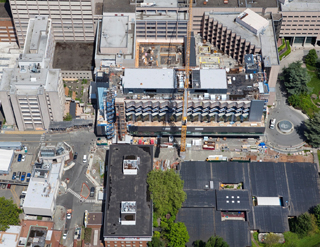|
Subscribe / Renew |
|
|
Contact Us |
|
| ► Subscribe to our Free Weekly Newsletter | |
| home | Welcome, sign in or click here to subscribe. | login |
Construction
| |
 |
June 23, 2011
UW expansion stays on track despite big change in plans
Skanska USA Building

Robinson
|
Midway through the first phase of the University of Washington Medical Center’s expansion project, UWMC made a series of changes to better serve its patients, including the addition of a highly technical bone marrow transplant unit.
Without creative thinking and collaboration, this sort of change could have significantly affected the project schedule. Instead, the project team — UW Capital Projects, Skanska, NBBJ and its consultants, MacDonald-Miller and Cochran — carried out a new-to-Washington design-assist solution to deliver the added scope.
The process allows for input from the contractor and subcontractors as well as early collaboration with the design team during the design phase. It provided the UWMC with a design and construction time line that was condensed by 10 weeks for the addition of the bone marrow transplant unit. Most important, it saved nearly $2 million.
Plans change
Work began in April of 2009 and was originally slated for completion next January. But by the end of 2009, the added scope, which consisted of three more shell-and-core floors, had pushed the time line out by five months.
In the spring of 2010, hospital administrators saw the need to reconfigure the patient care program within the building, swapping out a fifth-floor, 32-bed inpatient care unit in favor of a 30-bed eighth-floor adult acute care surgical oncology/bone marrow transplant unit.
This complex inpatient cancer therapy unit required a lengthy and thorough programming and design period, but UWMC needed it done quickly. This is where the design-assist approach became instrumental.
Contractors know that on traditional projects the core team initiates months of programming and design work to determine the client’s needs. The process leads to the development of final design and construction documents.
Once the documents are complete the work is put out to bid and subcontractors are secured. This is followed by several weeks of building-information modeling (BIM) and mechanical, electrical and plumbing (MEP) coordination to ensure all of the systems fit into the allotted space.
On complicated projects such as a bone marrow transplant unit, BIM and MEP coordination can take seven to 10 weeks. Once MEP coordination is complete, material fabrication takes place and construction may begin. The entire process can take up to 12 months from the start of design to the start of construction.
At UWMC, there were additional challenges with the design and coordination of the MEP systems related to the oncology and the bone marrow transplant unit.
Bone marrow transplant patients are immune-suppressed and require isolation with a constant flow of ultra-clean air. Since the addition of the bone marrow transplant unit came after UWMC’s core and shell had already been designed, the team had to ensure the MEP systems required for this complex facility fit within the limited ceiling space and within the new steel structure.
Design-assist process
To condense the project time line the project team determined the best approach would be to deploy the design-assist process and BIM. This innovative solution eliminated the traditional 10-week MEP coordination phase.
During the design phase, the team — including the owner, architect, GC/CM, plumbing contractor, sheet metal and pipe fitter, fire protection and electrical trades — created separate 3-D models for their systems. These were then integrated into one model. Clash-detection software was used to identify issues.
The team held multiple work sessions every week to resolve more than 120 design review comments and 500 MEP clashes. The process helped to validate design concepts, coordinate systems, identify conflicts and resolve issues.
“The team represented some 350 years of combined experience from multiple disciplines, all creatively collaborating to solve the clash at hand,” said the UW’s Jeff Angeley.
“The design-assist method provided us with a rapid and fluid system for design and construction. It has proven pivotal in helping us add a critical bone marrow transplant unit without extensively extending our time line.”
Potential improvements to layout, systems, materials, equipment and construction sequencing were easily analyzed and selected. The final model was exported to shop drawings, which led directly to prefabrication and streamlined installation.
State rule change
Until 2010, the Revised Code of Washington required GC/CM projects to separate construction work into individual scopes of work. Subcontractors would then submit lump-sum bids and were selected based on the lowest price. The process required the design to be completed before the subcontractors were selected, subsequently eliminating opportunities for collaborative input by MEP subcontractors.
Recently, legislators recognized these limitations and revised the RCW to allow for a mechanical contractor/construction manager and electrical contractor/construction manager to be hired prior to completion of the design. Even though in this case the project’s mechanical and electrical contractors, MacDonald-Miller and Cochran, were not procured as MC/CM or EC/CM, both provided the type of design assistance envisioned by the updated RCW.
While this is the first design-assist approach used in the state in conjunction with a GC/CM alternate procurement public works project, several others are now under way.
For an intricate build-out such as a bone marrow transplant unit, it delivered a sophisticated solution, saving critical time and significant costs.
Rob Robinson is a Skanska project executive overseeing the construction of University of Washington Medical Center’s expansion project. He has more than 22 years of health care and GC/CM experience.
Other Stories:
- 13 tips for choosing your medical space
- Swedish Issaquah aligns design with patient needs
- Good signage points the way to better health care
- 'Novel' process lets Swedish Issaquah hit fast forward
- ‘Hybrid’ rooms a low-cost answer to space needs
- Swedish women’s cancer center a one-stop shop
- Group Health is designing its clinic of the future
- Puyallup hospital tower puts focus on patients
- Evergreen opens center closer to its patients
- New VA complex to treat ‘emerging’ war injuries
- Friday Harbor hospital aims to be nation’s greenest
- Study will help UW’s Montlake Tower cut energy costs



